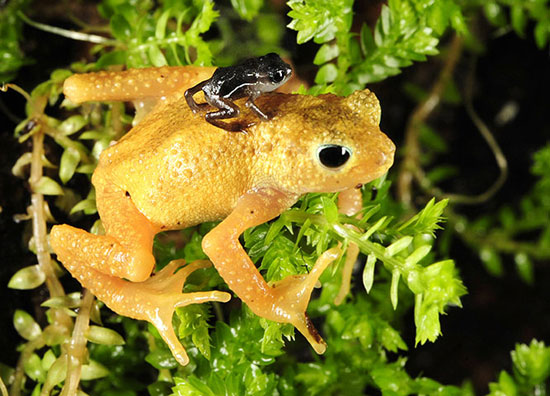Species of extinct to survive in the laboratory
Kihansi tiny toad is a rare species of extinct toad in the natural environment. However, according to LiveScience magazine, this toad thrives in a lab environment.

Kihansi, a tiny bush, carries his baby on his back - Photo: LiveScience
Kihansi water bushes adapt to moist soil due to the water spray from the waterfall. This toad is yellow with white belly skin, slightly clear, can see the intestine inside. They weigh only a few grams and belong to the group of amphibians that give birth instead of laying eggs. After giving birth, this toad will carry their offspring.
The first resident of this tiny toad was found in 1996, at an area near the height of a 0.9-kilometer waterfall created by the Kihansi River, Tanzania, and East Africa. According to scientists, this is probably the vertebrate 4-legged animal in the world's narrowest range.
The construction of dams at this waterfall has dramatically reduced the number of Kahansi toads in the area.LiveScience said scientists brought some of the toads into the Toledo, Ohio zoo and their population gradually recovered.
Now scientists are studying the possibility of bringing this tiny toad into the natural habitat.
- Huge mammals live harder, become extinct faster
- Development technology revives extinct species?
- The largest big animals on the planet (Part 1)
- More than 500 species of birds in the world are extinct
- Discovered the rare and extinct bat species
- Consequences when mosquitoes become extinct
- 600 species of plants disappear, threatening human survival
- Rediscover 3 extinct amphibian species
- Discovering the 'love path' where 5 species of humans mate in deformities
- Species of extinct animals suddenly appeared in Thanh Hoa
- Discovered frog species extinct 20 years ago
- Which species will 'inherit' the Earth when humans become extinct?
 Animal 'suffering' after hibernation
Animal 'suffering' after hibernation Why do goats climb well?
Why do goats climb well? Scientists were surprised to see chimpanzees eating turtles
Scientists were surprised to see chimpanzees eating turtles Giant catfish died deadly due to drought in Thailand
Giant catfish died deadly due to drought in Thailand